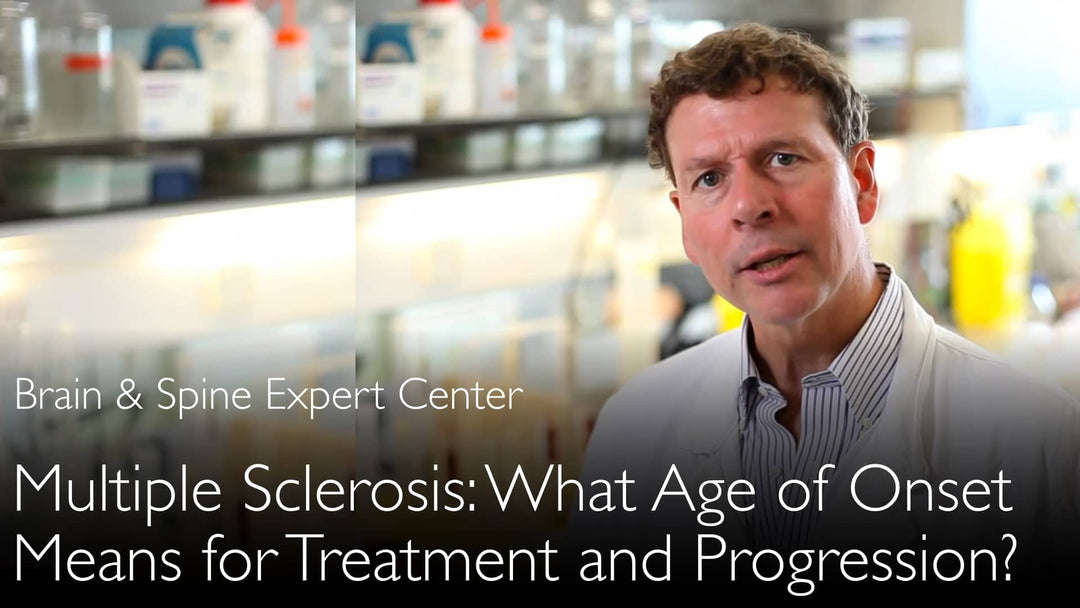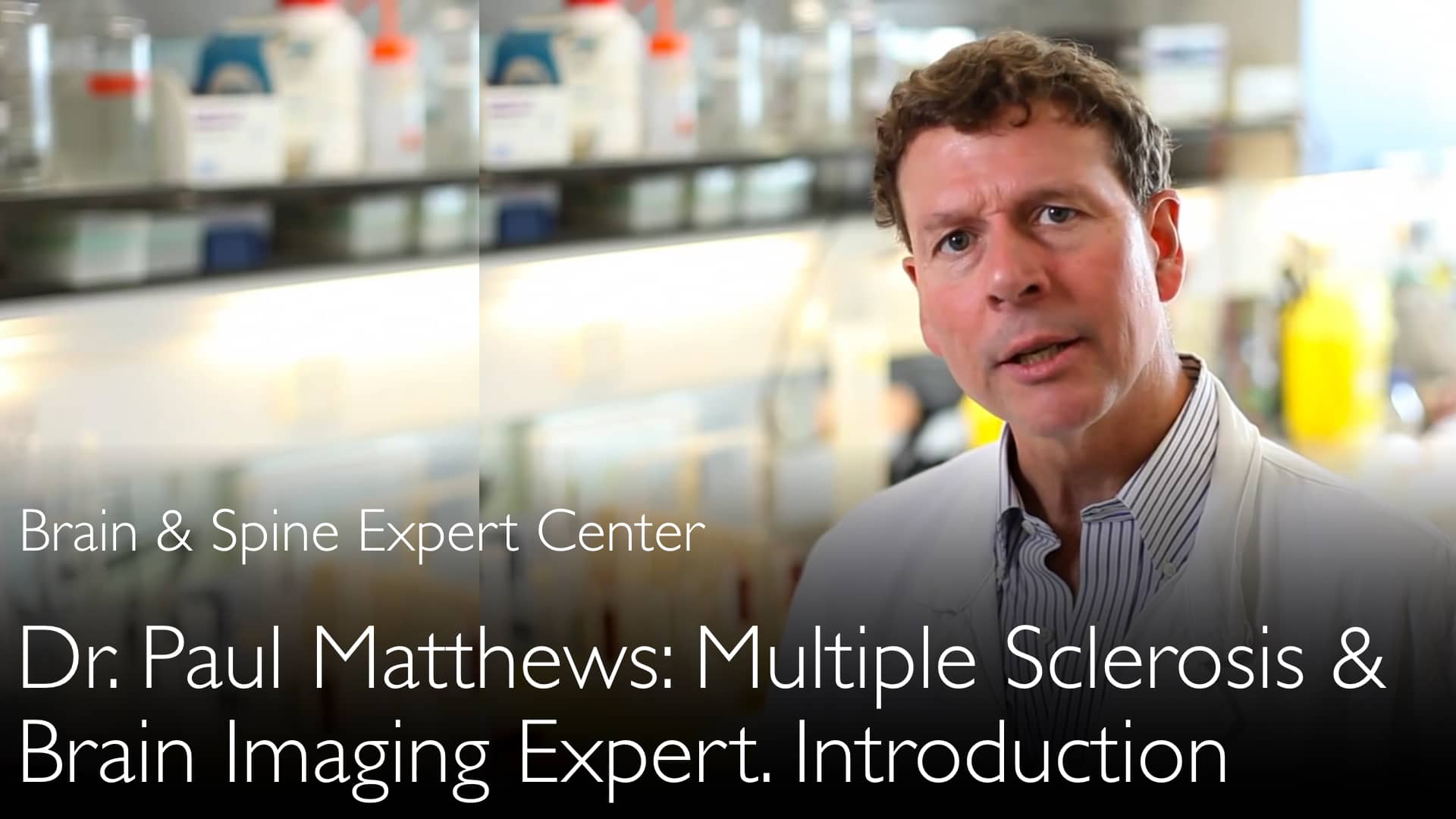Le Dr Paul Matthews, MD, expert de renommée mondiale dans le domaine de la sclérose en plaques, explique comment l’âge d’apparition de la maladie influence son évolution et sa prise en charge. Ses analyses IRM avancées montrent que les patients plus âgés présentent une neurodégénérescence plus agressive. Les données d’essais cliniques confirment une forte interaction entre les processus inflammatoires et le vieillissement cérébral. Ces découvertes ont des implications majeures pour le pronostic et les stratégies thérapeutiques dans la prise en charge de la sclérose en plaques.
Âge de Début de la Sclérose en Plaques : Impact sur le Pronostic et la Stratégie Thérapeutique
Aller à la Section
- Âge de Début dans la Sclérose en Plaques
- Données d'Essais Cliniques sur la Progression de la SEP
- Analyse IRM et Neurodégénérescence
- Ratios Sexuels et Différences de Présentation
- Lien entre Inflammation et Vieillissement Cérébral
- Implications Thérapeutiques et Pronostic
- Transcription Intégrale
Âge de Début dans la Sclérose en Plaques
La sclérose en plaques touche principalement les jeunes adultes. Selon le Dr Paul Matthews, ces patients présentent souvent une forme rémittente de la maladie. L’âge d’apparition des premiers symptômes constitue un facteur pronostique majeur, influençant significativement l’évolution clinique à long terme.
Données d'Essais Cliniques sur la Progression de la SEP
Un essai clinique majeur, analysé par le Dr Paul Matthews, a comparé des patients de même âge moyen en contrôlant la durée de la maladie. Les résultats ont montré que les patients plus âgés présentaient systématiquement une évolution plus agressive, indépendamment de l’ancienneté du diagnostic. Cela confirme que l’âge lui-même est un déterminant clé du handicap.
Analyse IRM et Neurodégénérescence
Le Dr Paul Matthews a utilisé des techniques d’imagerie par résonance magnétique avancées. Les IRM ont révélé des lésions plus profondes dans la substance blanche diffuse chez les patients âgés, indiquant une perte accrue de cellules cérébrales et d’axones, soit une neurodégénérescence. Ces observations expliquent biologiquement l’aggravation plus rapide chez les patients à début tardif.
Ratios Sexuels et Différences de Présentation
L’essai clinique a également mis en évidence des variations démographiques. Le Dr Paul Matthews note des écarts dans la répartition par sexe entre les groupes selon l’âge de début. Ces différences suggèrent que les mécanismes biologiques de la maladie pourraient varier en fonction de l’âge au moment de la manifestation.
Lien entre Inflammation et Vieillissement Cérébral
Le Dr Paul Matthews souligne une interaction étroite entre l’inflammation et la neurodégénérescence. La sclérose en plaques et le vieillissement cérébral sont intimement liés, un phénomène également observé dans d’autres maladies neurodégénératives comme Alzheimer. Dans tous ces cas, l’âge avancé reste le principal facteur de risque, révélant une vulnérabilité biologique commune.
Implications Thérapeutiques et Pronostic
Ces constats ont des répercussions directes sur la prise en charge. Comprendre que l’âge influence indépendamment la progression de la SEP modifie les stratégies thérapeutiques. Une approche plus intensive dès le départ pourrait être justifiée chez les patients plus âgés. Le Dr Paul Matthews confirme que ces données corroborent les études épidémiologiques, faisant de l’âge de début un critère essentiel pour prédire le pronostic et personnaliser les traitements.
Transcription Intégrale
Dr. Anton Titov, MD: La sclérose en plaques apparaît généralement chez les jeunes adultes, avec une évolution souvent rémittente.
Chez la majorité des patients, elle finit par devenir progressivement handicapante, évoluant vers une forme secondairement progressive.
Les études sur l’histoire naturelle de la maladie ont montré que l’âge affecte la progression de la SEP indépendamment de sa durée.
Vous avez réalisé une analyse IRM sophistiquée des cas de sclérose en plaques.
Dr. Paul Matthews, MD: Les patients étudiés étaient similaires en tout point, sauf en âge.
Que révèlent vos essais cliniques, et quelles implications pour la prise en charge ?
Dr. Paul Matthews, MD: L’essai clinique a comparé des patients de même âge moyen en contrôlant la durée de la maladie. Il a montré que les patients plus âgés avaient une évolution plus agressive, associée à des lésions plus profondes, notamment dans la substance blanche diffuse.
Cela indique une perte accrue de cellules cérébrales et d’axones, donc une neurodégénérescence plus marquée.
Ces résultats sont cohérents avec les données épidémiologiques anciennes : la progression dépend de l’âge au début de la maladie.
L’essai met aussi en lumière des différences de ratios sexuels entre les débuts précoces et tardifs.
Globalement, ces éléments suggèrent une forte interaction entre inflammation et neurodégénérescence.
La SEP et le vieillissement cérébral sont probablement liés, un parallèle intéressant avec d’autres troubles neurodégénératifs.
Bien sûr, la maladie d’Alzheimer en est l’exemple le plus fréquent. Pour toutes, l’âge reste le principal facteur de risque.
Dr. Anton Titov, MD: Il existe d’autres facteurs biologiques prédisposants dans les maladies neurodégénératives, y compris la SEP.





